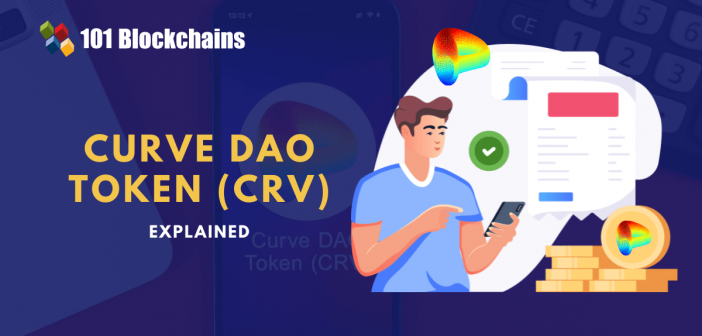The advent of decentralized finance or DeFi has introduced many promising implications for the future. Imagine a world where you can serve the same functions as a bank, such as lending money to borrowers. The exclusion of centralized intermediaries from financial services and applications becomes closer to reality with decentralized finance.
At the same time, innovation in the DeFi space has been evolving in the form of new solutions like Curve DAO and its native token. The DAO is an essential component of the Curve.fi ecosystem, which offers a blockchain-based decentralized exchange based on the principle of an automated market maker. The Curve token is the focal aspect of the distinctive UI of Curve Finance, which helps in capturing the true potential of the DeFi market.
Automated Market Makers or AMMs have introduced a significant effect on the overall crypto landscape with the development of liquidity platforms. Curve helps in swapping stablecoins with lower transaction costs and concerns of slippage. Why is Curve an important point of discussion in the DeFi world right now? The following discussion provides a detailed account of Curve DAO explained with references to how it works. In addition, you can also figure out the special highlights of the DAO token of Curve DeFi protocol.
Want to learn and understand the scope and purpose of DeFi? Enroll Now in Decentralized Finance Course!
Definition of Curve DAO Token
The first thing you need to know right now is the answer to “What is a Curve DAO token?” which can help you understand its significance. Also known as CRV, the native utility token of the Curve DeFi protocol is an important tool for exchanging stablecoins alongside other ERC-20 tokens. The primary goals of Curve DeFi protocol focus on connecting users interested in exchanging stablecoins and ERC-20 tokens through exchange protocols. Interestingly, the Curve DeFi platform is non-custodial, thereby entrusting users as the custodians of their own tokens.
The design of Curve Finance ensures low transaction fees and slippage through identification of the ideal routes for exchange requests of users. Curve leverages liquidity pools for facilitating the exchanges. Liquidity pools have the support of liquidity tokens and can encourage liquidity providers to deposit tokens in the pools.
The liquidity can help in maintaining the desired level of prices for transaction costs. At the same time, liquidity providers receive the necessary rewards for depositing their assets in the liquidity pools. Curve CRV is the utility token of the protocol and can help in incentivizing liquidity providers. The token holders can also use it for participating in network governance.
Working of Curve DAO Token
The next critical highlight in any discussion on Curve DAO CRV would refer to its working. CRV serves as the fuel for the Curve DeFi protocol, which itself serves as an automated market maker and decentralized exchange. AMMs serve a unique variant of trading that allows permissionless and automated exchange of assets. Rather than depending on order books, AMMs can help such protocols conduct trades automatically through different liquidity pools.
The liquidity providers would receive favorable incentives for creating liquidity pools and depositing tokens in the pools. Every pool features a specific token pair supported in the concerned liquidity pool only. The liquidity pools also feature similar assets for reducing impermanent loss alongside ensuring better possibilities for returns.
Liquidity pools and Automated Market Makers serve as major answers for how Curve DAO works for the future of DeFi. Most important of all, the protocol helps users find out about different exchange markets to discover the most favorable fee rates. As a result, Curve.fi can ensure that traders can improve their returns by reducing slippage. The frequency of trade on the Curve network by users serves good sign for the overall network. Liquidity providers could receive rewards from a portion of the trading fee paid by users.
Learn the fundamentals of Decentralized Finance (DeFi) with DeFi flashcards!
Founders of Curve DAO Token
The introduction to Curve DAO token must also focus on its founders to figure out the objectives behind designing such platforms. Michael Egorov, a Russian scientist, and cryptocurrency expert, is the founder of the Curve DeFi protocol. He launched the CRV token in 2020, and it has become one of the popular asset pools for exchanging Bitcoin and stablecoins as well as ERC-20 tokens. You can also think of CRV as a blockchain protocol focused on offering a platform for swapping assets. The decentralized trading environment also serves another crucial advantage for users as they can enable flexible trading in different crypto assets.
The experience of Michael Egorov in the blockchain and cryptocurrency domain is also evident in his role as co-founder of NuCypher. It is a fintech company with a specific focus on encryption and privacy-centric infrastructure and protocols.
What is Special about Curve DAO?
The discussions on Curve DAO explained in detail would generally draw attention to the specific reasons which make them special. Interestingly, the project has achieved considerably promising improvements in terms of utility. Curve DeFi protocol witnessed substantial growth in 2020 with the assurance of low transaction fees and low slippage. The detailed understanding of how Curve DAO works shows that it is successful on the grounds of technical capacity.
It is attractive not because it uses liquidity pools but for the AMM operating model. Users could easily figure out the best options for exchanges alongside facilitating exchange of stablecoins and tokens between traders and exchange protocols. The technology and technical capacity can help in exchanging stablecoins and tokens at the ideal rates. In other words, Curve has evolved as the perfect example of the closest thing to decentralized finance.
Want to learn blockchain technology in detail? Enroll Now in Certified Enterprise Blockchain Professional (CEBP) Course
Special Highlights of Curve DAO Token
The introduction to Curve DeFi protocol is incomplete without reflecting on the special highlights of its native token. The Curve DAO CRV token is the utility token for the DeFi protocol. It is basically an ERC-20 token operating on the Curve DEX. CRV basically serves as the governance token on the exchange. In addition, the token is also used for offering rewards to liquidity providers.
CRV token holders can play a vital role in defining the future direction of the Curve Finance DeFi protocol. Ownership of CRV tokens entitles the holders to voting power regarding the decisions for the Curve DEX protocol. Users locking their CRV tokens could exercise influence on operations of the DEX. For example, they can modify the fee structures or ensure voting for bringing in new yield pools.
The CRV token holders can also define the existing burning schedules for the token. Therefore, the Curve CRV token is more significant than serving as the utility token of Curve DeFi protocol. You should also note that voting power on the Curve DEX also depends on the length of time for which a user had a CRV token in their ownership. The increasing holding period could help in increasing the voting power, thereby defining CRV as a digital asset.
Tokenomics of Curve DAO Token
The immediate thing on your mind regarding the Curve DeFi protocol would point to a review of CRV coinmarketcap statistics. You must be eager to know more about the details of how Curve DeFi protocol works right now. CRV does not feature any ICO, and the only metric for its measure is through stake drop. Stake drop or Apy mining are the two methods for mining CRV tokens. A user pre-mined more than 80,000 CRV tokens through a code found on Github of the Curve DAO token. Following a comprehensive review of the code, CRV DAO offered acceptance for the token launch.
As of now, the total supply of CRV amounts to almost 3 billion tokens. Almost 5% of the tokens would help in issuing addresses to offer liquidity for the decentralized exchange. In addition, the DAO reserves of the project receive around 5% of the tokens. On top of it, the next 3% of the supply has been reserved for employees in Curve decentralized exchange. Subsequently, 30% of the supply of tokens has been reserved for employees in the Curve DeFi protocol.
Furthermore, you must note that 62% of the remaining tokens are reserved for the CRV future alongside the existing liquidity providers. The Curve DAO CRV would follow an annual reduction of 2.25% in their distribution schedule by ensuring the daily distribution of almost 766,000 CRV tokens. Surprisingly, the process of issuing the remaining CRV tokens at the existing rate might extend for the future 300 years.
You can find the CRV coin market cap estimate by multiplying the number of coins in circulation with the existing CRV price. The market cap is an essential highlight for ranking the crypto token against its peers alongside determining its suitable market share.
Want to become a cryptocurrency expert? Enroll Now in Cryptocurrency Fundamentals Course!
Value Drivers for Curve DAO Token
The answers to “What is a Curve DAO token?” also create doubts regarding the long-term potential of the project. The AMM technology and features such as an engaging interface strengthen the popularity of Curve.fi protocol among users. Who would want to avoid the benefit of low slippage and transaction fees in exchanging cryptocurrencies and tokens?
The utility of Curve token and its role in governance of the DeFi protocol would drive its real-world value. In addition, other crucial factors, including upgrades, upgrades, and increasing adoption, could influence the value of CRV in the future. The growing adoption of DeFi solutions can play a vital role in dramatic changes in the CRV price within a short period.
Price Analysis for CRV Token
The detailed overview of Curve DAO explained, especially in terms of its value, would point to price analysis for the token. Curve DeFi protocol is obviously a unique decentralized exchange with DAO governance, which sets it apart from other decentralized exchanges. It has evolved as one of the ideal protocols for serving the needs of stablecoin exchanges.
After the airdrop in 2020, along with a vesting period amounting to 4 years, CRV must stake the complex and time-locked payoffs. How? The total fee accrued by the Curve DeFi protocol resulted in such promising payoffs. In addition, a closer assessment of the Curve CRV protocol can serve a clear impression of the growth in interest. The statistics for the token, such as trading volume and on-chain transactions alongside total value locked or TVL for the protocol, can help in learning more about the price statistics.
In the initial days following its launch, the trading value of CRV token on Uniswap was almost $1275. During this time, CRV tokens offer a low ratio in the Uniswap pools when compared with other digital assets. On top of it, adding more cryptocurrencies to the asset pool ensured a plummeting drop in the price of CRV.
Want to learn the basic and advanced concepts of Stablecoin? Enroll Now in Stablecoin Fundamentals Masterclass Course!
Additional Rewards for Liquidity Providers
The liquidity pools of Curve DeFi protocol serve as the most important highlights. As a popular DEX aggregator, Curve Finance ensures that crypto users can find the ideal exchanges for their needs. At the same time, the protocol also compensates liquidity providers for staking their assets in liquidity pools on the platform. The liquidity pools feature Ethereum-based smart contracts, and majority of the liquidity pools on Curve protocol are supplied to other liquidity protocols like Compound. Liquidity providers can receive additional interest other than the trading fees offered to Curve.fi network.
The technical design of liquidity pools shows that they are basically smart contracts containing tokens. If you want to create a liquidity pool with two similar tokens, you must maintain a 1:1 ratio in the value of the two tokens. For example, if you have DAI and USDC in a token pair, then the USDC balance would decrease when someone exchanges DAI for USDC in the pool. In such cases, the difference in amount would reduce the value of USDC by a marginal difference in comparison to DAI. As a result, the mechanism would encourage crypto users to exchange USDC in return for DAI, thereby ensuring that the values become even.
Security of Curve DAO Token Network
The most important aspect in an introduction to Curve DAO explained comprehensively would focus on its security. The DAO governance is an important part of ensuring the security of the DeFi protocol’s network. Most important of all, regular audits of smart contracts used for creating the liquidity pools can help in securing the network and tokens.
The Curve DAO token operates on the Ethereum network, thereby ensuring a visible transition towards Proof of Stake consensus in the future. Proof of Stake serves the benefits of better cost-effectiveness and energy efficiency in comparison to Proof of Work protocol. In addition, CRV tokens could also be staked alongside locked for voting in order to help holders engage in network governance.
Start learning Decentralized Finance (DeFi) with World’s first DeFi Skill Path with quality resources tailored by industry experts Now!
Bottom Line
The rise of DeFi solutions has been one of the most revolutionary highlights in the crypto space. Curve DeFi protocol is the perfect example of using innovation to address user needs. The functionalities of Curve DAO CRV token as a utility token as well as governance token separate it from other decentralized exchanges. With the unique operating model as a decentralized exchange aggregator, Curve.fi protocol can reach out to more users in the future.
In addition, the additional opportunities for liquidity providers can also play a crucial role in driving the value of CRV tokens in the future. As of now, Curve relies profoundly on the value proposition of guiding users to the suitable decentralized exchanges offering the best rates. Learn more about Curve.fi protocol and its role in the future of DeFi now.
Join our annual/monthly membership program and get unlimited access to 25+ professional courses and 55+ on-demand webinars.
*Disclaimer: The article should not be taken as, and is not intended to provide any investment advice. Claims made in this article do not constitute investment advice and should not be taken as such. 101 Blockchains shall not be responsible for any loss sustained by any person who relies on this article. Do your own research!




